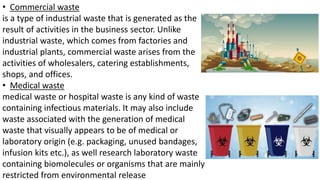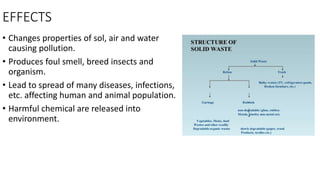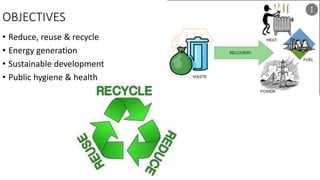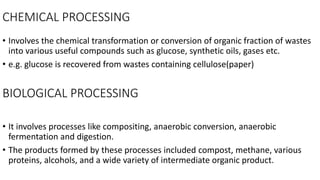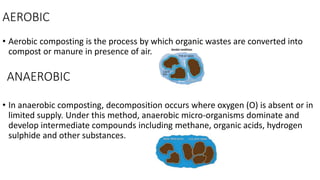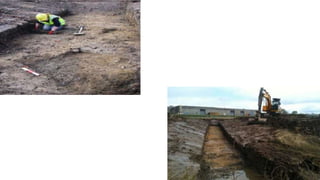solid waste management.pptx
- 2. CONTENT TYPES OF WASTE WHAT IS SOLID WASTE ? WHAT IS SOLID WASTE MANAGEMENT ? TYPES OF SOLID WASTE METHODS OF TREATMENT OF SOLID WASTE
- 3. WHAT IS WASTE? • Waste are unwanted or unusable materials. Waste is any substance which is discarded after primary use, or is worthless, defective and of no use. A by-product by contrast is a joint product of relatively minor economic value. A waste product may become a by-product, joint product or resource through an invention that raises a waste product's value above zero.
- 4. Based on physical state • Solid waste • Liquid waste • Gaseous waste Based on biodegradable state • Biodegradable waste • Non biodegradable waste Based on human health • Hazardous waste • Non hazardous waste TYPES OF WASTE
- 5. • Bio degradable waste : Biodegradation is the breakdown of organic matter by microorganisms, such as bacteria and fungi.Biodegradable waste can be found in municipal solid waste (sometimes called biodegradable municipal waste, or as green waste, food waste, paper waste and biodegradable plastics). Other biodegradable wastes include human waste, manure, sewage, sewage sludge and slaughterhouse waste. In the absence of oxygen, much of this waste will decay to methane by anaerobic digestion.
- 6. • Non biodegradable waste : it is defined as a substance that cannot be decomposed or dissolved naturally and acts as a source of pollution. plastics, metal, aluminum cans, tires, pains, toxic chemicals, toxic chemicals, polystyrene, etc.
- 7. • Municipal waste MSW includes commercial and residential wastes generated in municipal or notified areas in either solid or semi-solid form excluding industrial hazardous wastes but including treated bio-medical wastes. It consists of household waste, wastes from hotels and restaurants, construction and demolition debris, sanitation residue, and waste from streets. • garden waste Garden waste is the accumulated plant matter from gardening activities which involve cutting or removing vegetation, i.e. cutting the lawn, weed removal, hedge trimming or pruning consisting of lawn clippings. leaf matter, wood and soil. The composition and volume of garden waste can vary from season to season and location to location.
- 8. • Commercial waste is a type of industrial waste that is generated as the result of activities in the business sector. Unlike industrial waste, which comes from factories and industrial plants, commercial waste arises from the activities of wholesalers, catering establishments, shops, and offices. • Medical waste medical waste or hospital waste is any kind of waste containing infectious materials. It may also include waste associated with the generation of medical waste that visually appears to be of medical or laboratory origin (e.g. packaging, unused bandages, infusion kits etc.), as well research laboratory waste containing biomolecules or organisms that are mainly restricted from environmental release
- 9. • Agricultural waste: Waste generated from farming activities. These are mostly bio biodegradable. • E-waste : Electronic waste generated from any modern establishments. They may be discarded electrical or electronic devices. Some electronic scrap components, such as wires, circuits, mobile, computer etc.
- 11. WHAT IS SOLID WASTE? • A material which has negligible value to the producer and there is no direct composition of the generated waste. • It is generated due to various activities that can be residual and commercial, agricultural, etc. • Sources: o Municipal solid waste(MSW ): street sweeping, sewage treatment plant (stp), waste from schools & other institution etc. o Domestic waste: garbage, paints, spoiled food etc. o Commercial waste , mining , agricultural waste, hospital waste, industrial waste, E waste.
- 12. EFFECTS • Changes properties of sol, air and water causing pollution. • Produces foul smell, breed insects and organism. • Lead to spread of many diseases, infections, etc. affecting human and animal population. • Harmful chemical are released into environment.
- 13. SOLID WASTE IN INDIA • 7.2 Million tones of hazardous waste. • 1sq km of additional landfill area every year. • About 150 million tones of high volume low hazard waste every year, which is mostly dumped on open low lying area. • Cities like Bengaluru produced 2000tonnes of waste per annum, the ever increasing waste has put pressure on hygienic condition of the city. • Estimated waste generation is 100000 MT/day. • Per capita waste generation ranges between 0.2-0.6 kg.
- 14. MOJOR DEFICIENCIES • Littering of garbage due to unorganized primary collection • Provision and operation of interim storage facilities unsatisfactory • Irregular garbage lifting • Transportation system not synchronize with storage facilities • processing/ treatment of MSW not practiced • Final disposal through dumping and not SLF
- 15. SOLID WASTE MANAGMENT • Defined as the discipline associated with control of generation, storage, collection, transport, processing and disposal of solid waste materials waste generation on site handling, storage and processing waste collection Waste transfer and transport Waste processing and recovery
- 16. OBJECTIVES • Reduce, reuse & recycle • Energy generation • Sustainable development • Public hygiene & health
- 17. separators Sorting plant Waste balers Conveyor belts
- 18. SOLID WASTE TREATMENT The processing methods available for management of solid waste 1. Segregation 2. Reduce, reuse & recycle 3. Chemical processing 4. Biological processing
- 19. SEGREGATION • Waste sorting is the process by which is separated into different elements. • Dividing waste into dry and wet . • Can be segregated as biodegradable non biodegradable
- 20. REDUCE, REUSE & RECYCLE • Reduction : it focus on the source of waste, source reduction is carried out when products are designed, manufactured, packed, and used in way that limits the amount or toxicity of waste created. • Reuse: is when an items is cleaned and the material are used again. • Recycle : reproducing of disposed material into new and useful products.
- 21. CHEMICAL PROCESSING • Involves the chemical transformation or conversion of organic fraction of wastes into various useful compounds such as glucose, synthetic oils, gases etc. • e.g. glucose is recovered from wastes containing cellulose(paper) BIOLOGICAL PROCESSING • It involves processes like compositing, anaerobic conversion, anaerobic fermentation and digestion. • The products formed by these processes included compost, methane, various proteins, alcohols, and a wide variety of intermediate organic product.
- 22. COMPOSTING • It is controlled biological decomposition of organic matter, such as food and yard waste, into humns. • Composting is the natural process of rotting or decomposition of organic matter by micro organism under controlled. • It can be anaerobic and aerobic and vermicompound . • This process takes about 4-6 weeks BENEFITS oProvides nutrients to the soil oIncreases beneficial soil organisms oProtects soil from erosion oAssist pollution remediataion
- 23. AEROBIC • Aerobic composting is the process by which organic wastes are converted into compost or manure in presence of air. • In anaerobic composting, decomposition occurs where oxygen (O) is absent or in limited supply. Under this method, anaerobic micro-organisms dominate and develop intermediate compounds including methane, organic acids, hydrogen sulphide and other substances. ANAEROBIC
- 24. VERMICOMPOSTING • Vermicomposting is a simple biotechnology process of composting, in which certain species of earthworms are used to enhance the process of waste conversion and produce a better product. • Easiest method to recycle agricultural waste • Earthworms consume biomass and excrete it in digested form called worm casts/black gold.
- 25. TYPES OF VERMICOMPOSTING • SMALL SCALE VERMICOMPOSTING : Personal requirement (5-10 tonnes of vermicompost annually) • LARGE SCALE VERMICOMPOSTING: Commercial sacle (50-100 tonnes annually) METHODS Bed method :composting is done on kuccha floor by making bed (6*2*2 feet) of organic mixture. This method id easy to maintain and to practice. Pit method :composting is done in the cemented pits of size (5*5*3feet). The unit is covered with thatch grass or other locally available materials. This method is not preferred due to poor aeration, water logging at bottom, and more cost of production.
- 27. STEPS FOLLOWED FOR VERMICOMPOST PREPARATION • Composting unit should be in a cool, moist and shady site. • Cow dung and chopped dried leafy materials are mixed in proportion of 3:1. • Kept in partial decomposition for 15-20 days. • A layer of 15-20cm of chopped dried leaves/grasses should be kept as bedding material at the bottom of the bed. • Beds of partially decomposed material of size 6*2*2 feet should be made. • Each bed should contain 1.5-2 q of raw material and the number of beds can be increased as per raw material availability and requirement. • Red earthworm (1500-2000) should be released on the upper layer on bed. • Water should be sprinkled with can immediately after the release of worms. • Bed should be kept moist by sprinkling of water (daily) and by covering with gunny bag. • Bed should be turned once after 30 days for maintaining aeration and for proper decomposition. • Compost get ready in 45-50 days. • The finished product is 3/4th of the raw material cost. https://youtu.be/2F3kdjDdF0w
- 28. LANDFILLING • Landfill site is a site for the disposal of waste materials by burial and is the oldest form of waste treatment. • Waste is directly dumped into mining voids or borrow pits. Disposed waste is compacted and covered with soil. • Gases generated by the decomposing waste materials are often burnt to generate power. LANDFILLING CAN BE DONE BY THREE METHODS: • Trench method • Area method • Ramp method
- 30. TRENCH METHOD • The trench method consist of an excavated into which the solid wastes are spread, compacted and covered. • The trench method is best suited for nearly level land where the water table is not near the surface AREA METHOD • The area method is best suited for flat or gently sloping area where some land depression may exist. • The wastes are spread, compacted and then covered
- 32. RAMP METHOD • It is also known as depression method. • The slope or ramp is sometimes used in combination with the slope, compacted and covered. ADVANTAGES Landfill site is a cheap waste disposal option. The gas given of by the landfill site could be collected and used for generating power. Lots of different types of waste can be disposed of by landfill in comparison to other waste disposal method. DISADVANTAGES Can be pollute air, water and also the soil. Can contribute to the global warming.
- 33. INCINERATION • Incineration is a waste management technology that involves the combustion of organic material • It is carried out at high temperature. • The waste material is converted into ash, flue gases, particulates and heat. TYPES OF INCINERATORS: Moving grate Fixed grate Fluidized bed Rotary kiln ADVANTAGES • Less space requirement • Hygiene process DISADVANTAGES • Expensive process • Special care required
- 35. PYROLYSIS Defined as thermal degradation of waste in the absence of air to produce char, pyrolysis oil & syngas, e.g. the conversion of wood to charcoal also it is defined as destructive distillation of waste in absence of oxygen. External sources of heat is employed in this process.







